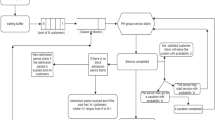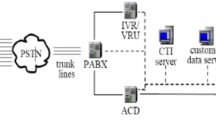Abstract
A model of a queueing network with several input Poisson flows is considered. These flows require connections between given terminals. The connection path depends on the type of the customer, the requested resource, the paths currently occupied, and on the overall load on communication channels of the network. A fast simulation method for evaluation of blocking probability for customers of a certain flow with a required resource not lower than the given one is proposed.
Similar content being viewed by others
References
K.W. Ross, Multiservice Loss Models for Broadband Telecommunication Networks, Springer-Verlag, London (1995).
I. B. Frenkel, A. Karagrigoriou, A. Lisnianski, and A. V. Kleyner, Applied Reliability Engineering and Risk Analysis: Probabilistic Models and Statistical Inference, John Wiley & Sons, New York (2013).
E. Nyberg, J. Virtamo, and S. Aalto, “An exact algorithm for calculating blocking probabilities in multicast networks,” in: G. Pujolle, H. Perros, S. Fdida, U. Korner, and I. Stavrakakis (eds.), Networking 2000: Broadband Communications, High Performance Networking, and Performance of Communication Networks; Lecture Notes in Computer Science, Vol. 1815, Springer-Verlag, Berlin–Heidelberg (2000), pp. 275–286.
J. Karvo, “Efficient simulation of blocking probabilities for multi-layer multicast streams,” in: E. Gregori, M. Conti, A. Campbell, C. Omidyar, and M. Zukerman (eds.), Networking 2002: Networking Technologies, Services, and Protocols; Performance of Computer and Communication Networks; Mobile and Wireless Communications; Lecture Notes in Computer Science, Vol. 2345, Springer, Berlin–Heidelberg (2002), pp. 1020–1031.
I. N. Kovalenko and N. Yu. Kuznetsov, Methods to Design Highly Reliable Systems [in Russian], Radio i Svyaz’, Moscow (1988).
I. N. Kovalenko, N. Yu. Kuznetsov, and Ph. A. Pegg, Mathematical Theory of Reliability of Time Dependent Systems with Practical Applications, Wiley, Chichester (1997).
N. Yu. Kuznetsov, “Fast simulation technique in reliability evaluation of Markovian and non-Markovian systems,” in: Simulation and Optimization Methods in Risk and Reliability Theory, Nova Sci. Publ., New York (2009), pp. 69–112.
P. Heidelberger, “Fast simulation of rare events in queueing and reliability models,” ACM Trans. Modeling Comput. Simul., Vol. 5, Iss. 1, 43–85 (1995).
P. Glasserman, Monte Carlo Methods in Financial Engineering, Springer, New York (2004).
M. S. Ermakov, “Importance sampling for simulation of large and moderate deviation probabilities of tests and estimators,” Theory Probab. Appl., Vol. 51, No. 2, 279–290 (2007).
J. Li, A. Mosleh, and R. Kang, “Likelihood ratio gradient estimation for dynamic reliability applications,” Reliab. Eng. and System Safety, Vol. 96, No. 12, 1667–1679 (2011).
V. S. Kouikoglou and A. Ph. Yannis, “Review of a fast simulation method for the analysis of queueing networks,” Applied Stochastic Models and Data Analysis, Vol. 13, Iss. 2, 73–83 (1998).
M. Falkner, M. Devetsikiotis, and I. Lambadaris, “Fast simulation of networks of queues with effective and decoupling bandwidths,” ACM Trans. on Modeling and Comput. Simulation, Vol. 9, Iss. 1, 45–58 (1999).
N. Yu. Kuznetsov and A. A. Shumskaya, “Evaluation of the hazard of failure of the redundant system by fast simulation methods,” J. Autom. Inform. Sci., Vol. 45, No. 5, 38–51 (2013).
B. L. Fox and P. W. Glynn, “Discrete-time conversion for simulating finite-horizon Markov processes,” SIAM J. Appl. Math., Vol. 50, No. 5, 1457–1473 (1990).
A. A. Shumskaya, “Fast simulation of unavailability of a repairable system with a bounded relative error of estimate,” Cybern. Syst. Analysis, Vol. 39, No. 3, 357–367 (2003).
P. Glasserman, Ph. Heidelberger, P. Shahabuddin, and T. Zajic, “Multilevel splitting for estimating rare event probabilities,” Oper. Res., Vol. 47, No. 4, 585–600 (1999).
S. Juneja, P. Shahabuddin, and T. Zajic, “Splitting-based importance-sampling algorithm for fast simulation of Markov reliability models with general repair-policies,” IEEE Trans. on Reliability, Vol. 50, No. 3, 235–245 (2001).
A. Lagnoux, “Rare event simulation,” Probab. Eng. and Inf. Sci., Vol. 20, No. 1, 45–66 (2006).
I. B. Gertsbakh and Y. Shpungin, Models of Network Reliability: Analysis, Combinatorics, and Monte Carlo, CRC Press, Boca Raton (2009).
J. Blanchet and H. Lam, “Rare event simulation techniques,” in: Proc. 2011 Winter Simulation Conf. (2011), pp. 217–231.
Author information
Authors and Affiliations
Corresponding author
Additional information
Translated from Kibernetyka ta Systemnyi Analiz, No. 4, July–August, 2021, pp. 30–43.
Rights and permissions
About this article
Cite this article
Kuznetsov, N.Y., Kuznetsov, I.N. Fast Simulation of the Customer Blocking Probability in Queueing Networks with Multicast Access. Cybern Syst Anal 57, 530–541 (2021). https://doi.org/10.1007/s10559-021-00378-2
Received:
Published:
Issue Date:
DOI: https://doi.org/10.1007/s10559-021-00378-2




